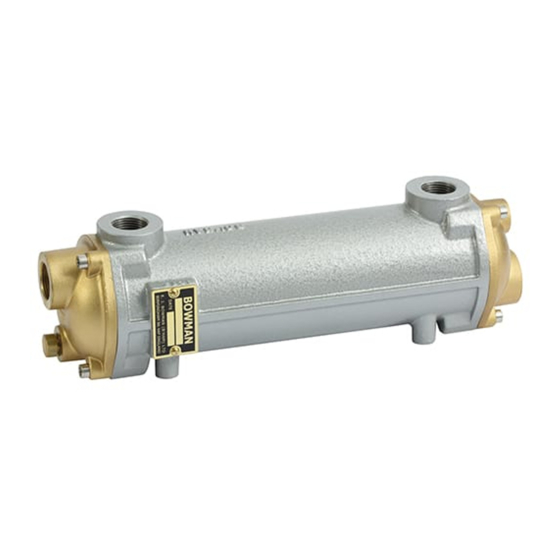Summary of Contents for BOWMAN EC Series
- Page 1 Installation, Operation & Maintenance Guide HYDRAULIC OIL COOLERS BOWMAN ® Heat Exchanger Technology by 1 0 0 Y E A R S O F H E AT T R A N S F E R T E C H N O L O G Y...
-
Page 2: Table Of Contents
Introduction Thank you for purchasing a high quality Bowman hydraulic oil cooler. Bowman® has been manufacturing hydraulic oil coolers for over 60 years and our products are renowned for their quality, heat transfer performance and durability. Please read this ‘Installation, Operation & Maintenance Guide’ carefully before installation to ensure your hydraulic oil cooler operates efficiently and reliably. -
Page 3: Safety
1. Safety 1.1 Hazards When Handling the oil cooler BOWMAN® Hydraulic Oil Coolers are constructed to current practice and recognised safety standards. Hazards may still arise from operation, such as: • Injury of the operator or • Third parties or •... -
Page 4: Potential Hazards
The maximum permissible operating temperature must not exceed: Oil side: 120º C Cooling Water side: 110ºC Variants with higher temperature and pressure ratings are available. Please contact the Sales for further details 1.4 Potential Hazards Ensure the maximum permissible operating pressures are not exceeded. NB: Before the oil cooler is disconnected it must be allowed to cool and Caution be depressurized. -
Page 5: Connecting The Cooler
Or in series: 2.3 Connecting the oil cooler Shut off all drainage valves in the flow and return pipes in both circuits. When fitting the oil cooler into the pipe work care must be taken to ensure that no debris has been introduced into the oil cooler. -
Page 6: Marine Installation
1m before the oil cooler, with the orifice size calculated to ensure that the maximum sea water flow rate cannot be exceeded. The correct orifice diameter can be determined from the table below. Three Pass Bowman Orifice diameter in mm for max. sea water flow Oil Coolers... -
Page 7: Operation
3. Operation 3.1 Maximum water flow rates The following tables give maximum flow rates through the tube stack for either single, two or three pass configuration, using either sea or fresh water. Take Care Sea Water Application (Maximum 2 m/s) 3-Pass 2-Pass 1-Pass... -
Page 8: Commissioning
4. Commissioning Commissioning of the oil cooler should not be undertaken until this document has been fully read and understood. Both circuits of the oil cooler must be closed prior to commissioning. Adequate provision should be made to ensure that correct operating/service Danger equipment along with personal protection equipment (PPE) in accordance with current standards/legislation is used prior to the commencement of any working. -
Page 9: General Maintenance
While the unit is in operation, weekly inspection of the heat exchanger and its connections should be made for leaks and externally visible damage. BOWMAN® recommend that the tubestack should be cleaned and inspected annually and the o rings should be renewed at this time. -
Page 10: Potential Service Issues
6. Potential Service Issues 6.1 Tube failures The majority of problems facing an oil cooler are those of corrosion or erosion on the water side. Three common types of failure are: a) Impingement attack (or erosion corrosion) This is caused by water containing air bubbles flowing at high speed through the tubes. The impingement of rapidly moving water may lead to a breakdown of the protective copper oxide film on the tubes thus allowing corrosion/erosion. -
Page 11: Warranty
BOWMAN® should be contacted immediately if a unit is received damaged. No attempt should be made to repair a faulty unit as this will invalidate the warranty. For full warranty terms, please see the BOWMAN® Conditions of Sale. A copy of which is available on www.ej-bowman.com request or via download from the website: 8. - Page 12 E J Bowman (Birmingham) Ltd, reserve the right to change specifications without prior notice. All material contained in this brochure is the intellectual property of E J Bowman (Birmingham) Ltd. It is protected under copyright and may not be reproduced without prior written consent of the company.






Need help?
Do you have a question about the EC Series and is the answer not in the manual?
Questions and answers